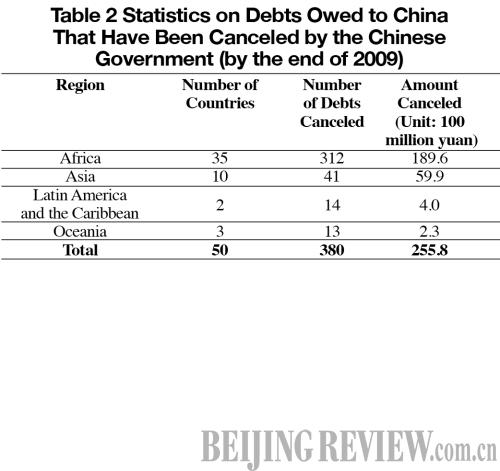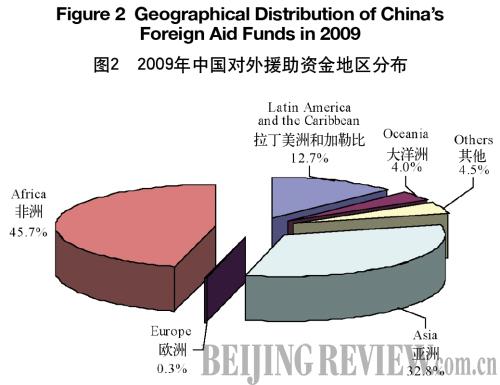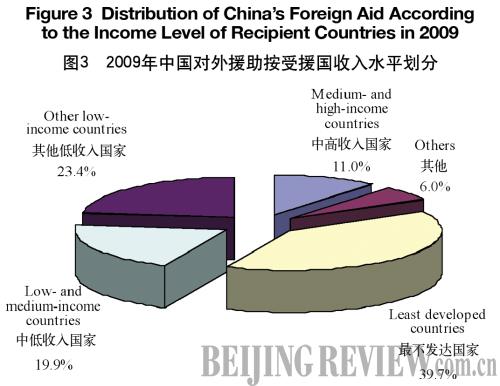|

IV. Distribution of Foreign Aid
The recipients of China's foreign aid are mainly low-income developing countries. Regarding the distribution of its foreign aid, China sets great store by people's living conditions and economic development of recipient countries, making great efforts to ensure its aid benefits as many needy people as possible.
Geographical Distribution
The geographical distribution of China's foreign aid shows a comparatively even coverage. The recipients cover most developing countries in Asia, Africa, Latin America, the Caribbean, Oceania and Eastern Europe. About two thirds of China's aid always goes to the least developed countries and other low-income countries. By the end of 2009, China had aided 161 countries and more than 30 international and regional organizations, including 123 developing countries that receive aid from China regularly. Of them, 30 are in Asia, 51 in Africa, 18 in Latin America and the Caribbean, 12 in Oceania and 12 in Eastern Europe. Asia and Africa, home to the largest poor population, have got about 80 percent of China's foreign aid.


Major Fields
China's foreign aid projects are oriented to agriculture, industry, economic infrastructure, public facilities, education, and medical and health care, with the focus on improving recipient countries' industrial and agricultural productivity, laying a solid foundation for their economic and social development, and improving basic education and health care. In recent years, coping with climate change has become a new area in China's foreign aid.
Agriculture
China makes agriculture, rural development and poverty reduction in developing countries priorities of its foreign aid. The agricultural aid mainly covers building farms, agro-technology demonstration centers, and experiment and promotion stations of agro-technology; constructing farmland irrigation and water-conservancy projects; supplying agricultural machinery and implements, farm produce processing equipment and related agricultural materials; dispatching agro-technicians and senior agricultural experts to pass on agricultural production technologies and provide consultations on rural development, and training agricultural personnel for recipient countries. Agricultural projects aided by China have promoted agricultural development in recipient countries, increased their output of grain and cash crops, and provided raw materials for the development of their light industry. In Guinea-Bissau, Chinese agricultural experts helped build 11 demonstration areas for paddy rice, with a total growing area of 2,000 ha. They bred 530 tons of fine strains of rice, which were planted in areas totaling 3,530 ha. Several of the rice strains produced an output three times or more than the original output. In 2008, the Chinese agricultural experts were awarded first prize for scientific and technological progress by the Agricultural Department of Guinea-Bissau. Chinese experts assisted in the operation of a hybrid rice development and demonstration center in Madagascar, where 34 strains of Chinese hybrid paddy rice were grown, with average per-ha output of 8 tons, about two to three times the average output of local paddy rice. In the 1960s and 1970s, after succeeding in helping Mali grow sugarcane, China went on to help the country establish sugarcane farm and sugar mills, enabling Mali to grow and process sugar by itself for the first time ever. This sugar-making corporation is playing an important role in Mali's economy. In the 1980s, China helped Tunisia construct the Medzerdah-Cap Bon Canal, which enabled the transfer of water from west to east for farmland irrigation, laying a solid foundation for agricultural development in Tunisia.
China has been increasing its aid for agriculture and grain production in particular. In recent years, food security has become a global issue, and China has adopted a series of measures to address this problem in its foreign aid. For instance, at the UN High-Level Meeting on the Millennium Development Goals in 2010, China pledged to establish 30 demonstration centers for agricultural technologies in other developing countries, dispatch 3,000 agricultural experts and technicians to these countries, and invite 5,000 agricultural personnel from these countries to China for training.
By the end of 2009, China had aided 221 agricultural projects in other developing countries—35 farms, 47 agro-technology experiment and promotion stations, 11 animal husbandry projects, 15 fisheries projects, 47 farmland irrigation and water-conservancy projects, and 66 other types of agricultural projects. On top of that, China had provided a large amount of agricultural equipment and materials to them.
Industry
Industrial aid was an important part of China's foreign aid in its early stage. From the 1950s to the 1970s, China helped many newly-independent Asian and African countries undertake a number of industrial projects. These projects, many of them first ever of their kind in these countries, laid the foundation for their industrial development. Industrial aid increased rapidly in the 1970s, constituting an important part of China's complete projects aid to other countries at that time. Since the mid-1980s, China gradually reduced its aid in this regard, as many developing countries stepped up privatization in the industrial sector. The industrial projects established with China's help have played an active role in promoting production and economic development, creating jobs, increasing tax revenues and invigorating markets in the recipient countries. By the end of 2009, China had helped developing countries construct 688 industrial production projects, covering light, textile, machinery, chemical, metallurgical, electronic, construction materials, and energy industries. Of these, the Hama Textile Mill in Syria, the Cement Factory in Rwanda, the Rioja Cement Factory in Peru, the Agriculture Machinery Factory in Myanmar and the Loutété Cement Factory in the Republic of Congo are always profitable. They employ a large number of local people and yield sound economic and social benefits.
Economic Infrastructure
Economic infrastructure construction is always an important part of China's foreign aid. Despite its limited foreign aid funds, China has made full use of the mature technologies and relative low cost of manpower to help other developing countries construct a host of infrastructure projects in transportation, communication, power supply, etc. By the end of 2009, China had helped other developing countries build 442 economic infrastructure projects, such as the Sana'a-Hodeida Highway in Yemen, the Karakoram Highway and Gwadar Port in Pakistan, the Tanzania-Zambia Railway, the Belet Uen-Burao Highway in Somalia, the Dry Dock in Malta, the Lagdo Hydropower Station in Cameroon, Nouakchott's Friendship Port in Mauritania, railway improvement in Botswana, six bridges in Bangladesh, one section of the Kunming-Bangkok Highway in Laos, the Greater Mekong Sub-region Information Highway in Myanmar, the Shar-Shar Tunnel in Tajikistan, the No.7 Highway in Cambodia, and the Gotera Interchange in Addis Ababa of Ethiopia. These projects have helped improve the environment of life and production for the local people, and create better conditions for the development of the local economy and society.
|
